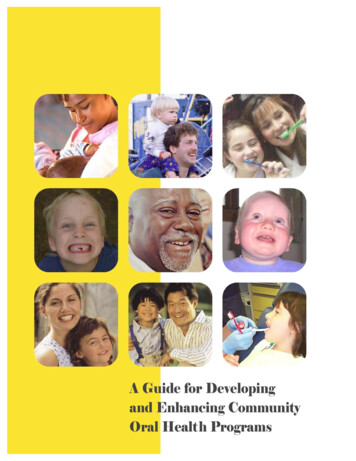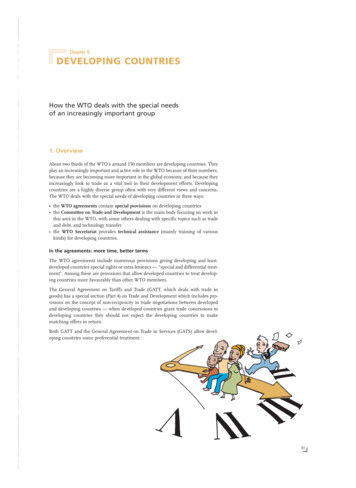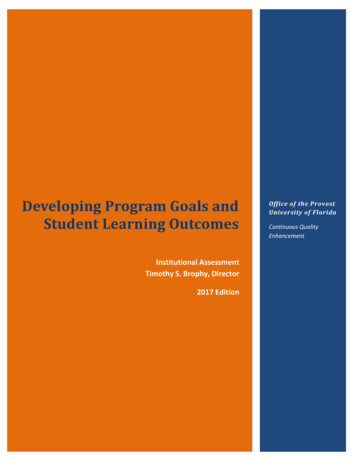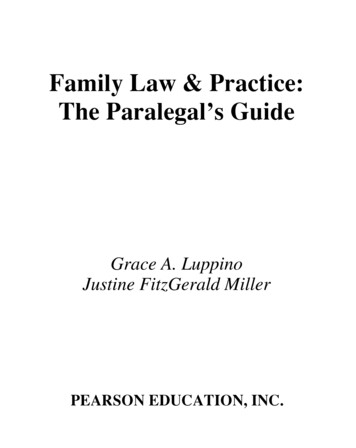
Transcription
A Guide for Developing and Enhancing Community Oral Health Programsi
AcknowledgementsA Guide for Developing and Enhancing Community Oral Health Programs (the Guide) wasproduced by the American Association for Community Dental Programs (AACDP), a nationalorganization focused on the needs and interests of public oral health programs in communitiesacross the nation. Through its Web site, discussion list, and publications, AACDP offersinformation, guidance, and technical assistance designed to promote community oral healthprograms. AACDP also promotes communication between stakeholders interested in communityoral health activities and sponsors an annual conference that focuses on issues of interest to localoral health program managers and staff. The conference is held in conjunction with the NationalOral Health Conference, thereby creating a synergy of opportunities for formal continuingeducation and networking with other professionals who have expertise in community public oralhealth program operations, research, policy, and funding.Other AACDP publications include the following: Seal America: The Prevention Invention. By developing this dental sealant manual, AACDPcontributed to successful efforts to retain major funding for state and local oral healthprograms through the Maternal and Child Health Block grant.Model Framework for Community Oral Health Programs: Based on the Ten Essential PublicHealth Services (http://www.aacdp.com/Docs/Framework.pdf). This document integratesoral health into each of the 10 essential public health services accepted by the NationalAssociation of City and County Health Officers. The document provides a conceptualframework and theoretical support for the integration of oral health and public health.For information on how to join AACDP to work with others in support of community oral healthprograms, visit http://www.aacdp.com.The Guide is the result of the commitment and efforts of a broad spectrum of oral health andpublic health experts including state, county, and city oral health directors and consultants, arepresentative of the Indian Health Service, and the chief dental officer of a multi-site ruralcommunity health center system. AACDP members and colleagues who led development of theGuide and contributed significantly to writing and reviewing the document includeRobert D. Jones, D.D.S.Chair, AACDP Local Oral Health Program Guide CommitteePresident, Maryland Association of County and City Dental Public Health OfficersM. Teresa Cunningham, R.D.H., M.S.Coordinator, AACDP Local Oral Health Program Guide CommitteeConsultant, Dental Public HealthA Guide for Developing and Enhancing Community Oral Health Programsi
Myron Allukian Jr., D.D.S., M.P.H.Oral Health Consultant, Massachusetts League of Community Health Centers and LutheranMedical CenterFormer Dental Director, City of BostonPatrick Blahut, D.D.S., M.P.H.Deputy Director, Indian Health Service ProgramGordon Empey, D.M.D., M.P.H.State Executive Dental Consultant, Oral Health Program, Office of Family Health, OregonDepartment of Human ServicesLawrence F. Hill, D.D.S., M.P.H.Dental Director, Cincinnati Health Department, Greater Cincinnati Oral Health CouncilPresident, AACDPSusan Sanzi-Schaedel, R.D.H., M.P.H.Program Manager, School and Community Dental Health, Multnomah County HealthDepartment, OregonHarvey Wallace, Ph.D.National Association of Local Boards of HealthHead, Department of Health, Physical Education, and Recreation, Northern Michigan UniversityScott Wolpin, D.M.D.Chief Dental Officer, Choptank Community Health System, Eastern Shore of MarylandPast President, Association of Clinicians for the UnderservedThis project could not have been completed without the support of the Health Resources andServices Administration’s Maternal and Child Health Bureau, and, specifically, without theassistance and encouragement of Mark Nehring, D.D.S., Oral Health Coordinator. Katrina Holt,M.P.H., M.S., R.D., director of the National Maternal and Child Oral Health Resource Center,also provided valuable assistance. Thanks also to the Association of State and Territorial DentalDirectors (ASTDD) for providing meeting support to AACDP’s Local Oral Health ProgramGuide committee. Finally, we would like to thank staff from Health Systems Research, Inc., andin particular Judith Gallagher, R.N., Ed.M., M.P.A., Maternal, Child and Community Healthdirector, for help writing and organizing the Guide.The online Guide was produced by Mindy Nash, Web Developer, National Maternal and ChildOral Health Resource Center (OHRC), with assistance from the following OHRC staff: RuthBarzel, M.A., senior writer/editor; Katrina Holt, M.P.H., M.S., R.D., director; and John Richards,Information Technology director.A Guide for Developing and Enhancing Community Oral Health Programsii
Table of ContentsAcknowledgementsExecutive SummaryOverview of the GuideStep 1. Mobilize Community SupportA. Getting StartedB. Finding Partners and ChampionsStep 2. Assess Needs and ResourcesA. Organize the AssessmentB. Conduct the AssessmentStep 3. Determine Priorities and Plan the ProgramA. Prioritize NeedsB. Plan for Integration of Cultural CompetenceC. Design the ProgramStep 4. Implement the ProgramA. Identify Program ComponentsB. Create an Implementation PlanStep 5. Evaluate the ProgramA. Determine How the Evaluation Will Be UsedB. Determine Evaluation QuestionsC. Develop Evaluation MeasuresStep 6. Participate in Policy Development and ResearchA. Community Oral Health PolicyB. Community Oral Health ResearchConclusionReferencesAppendicesA. Resources Organized by Steps in the Process of Developing, Integrating,Expanding, or Enhancing Community Oral Health ProgramsB. List of Resources by Topic AreaC. Effective Community and Individual Preventive Measures for Dental CariesPreventionD. Comparison of Five Effective Community Prevention Programs for Dental CariesE. Crosswalk Between 10 Essential Public Health Services, Essential Public HealthServices to Promote Oral Health in the United States, and Dental Public HealthCompetenciesA Guide for Developing and Enhancing Community Oral Health 393945505152iii
Executive SummarySince good oral health is essential to good overall health as well as to the prevention of oraldisease and unnecessary suffering, oral health is a major concern of local public health agencies(LPHAs). A Guide for Developing and Enhancing Community Oral Health Programs (theGuide) is designed to help LPHAs develop, integrate, expand, or enhance community oral healthprograms.LPHAs are well positioned to work with other community stakeholders to develop, integrate,expand, or enhance community oral health programs. Such stakeholders may include State and local government officialsState public health officialsLocal public health officials and administratorsHealth professionals, including oral health professionalsCommunity oral health coalitions and organizationsLocal nonprofit health agencies, organizations, and institutionsOthers involved with advocating for, planning, and implementing community oral healthprogramsThe Guide is a companion document to A Model Framework for Community Oral HealthPrograms: Based on the Ten Essential Public Health Services(http://www.aacdp.com/Docs/Framework.pdf) (the Framework). The Framework is a policydocument describing the integration of oral health into the 10 essential public health services thatofficially guide the membership of the National Association of County and City Health Officers(NACCHO). The Framework can be used to help ensure that oral health is included in LPHAs’overall plan. The Guide walks readers through the steps needed to develop, integrate, expand, orenhance community oral health programs.Although the Guide is organized by steps, the process of program development, integration,expansion, or enhancement is not necessarily linear. In some cases, certain steps may havealready been completed—for example, mobilizing community support or assessing oral healthneeds and existing resources. Conducting several steps simultaneously is an option. It isimportant to build on and move ahead with what has already been accomplished.The steps detailed in the Guide include the following:1.2.3.4.5.6.Mobilize community supportAssess needs and existing resourcesPlan the programImplement the programEvaluate the programParticipate in policy development and researchThroughout the Guide, resources related to each step are identified and described. Web siteaddresses are provided when available.A Guide for Developing and Enhancing Community Oral Health Programsiv
Important to the success of community oral health program development, integration, expansion,or enhancement is the identification and mobilization of program resources. These resources mayinclude existing services and equipment as well as financial resources. While the Guide containsa section that specifically addresses funding, it is important to view each step described in theGuide as integral to the funding process. For example, through the mobilization of communitysupport, communities are creating an oral health constituency that can influence the budgetingprocess and the allocation of funds to support oral health. The development of a program plandriven by an assessment of oral health needs and existing resources and that builds in programevaluation is attractive to funders, who are concerned with accountability. Therefore, each stepdescribed in the Guide is intended to help readers identify and mobilize resources.Step 1. Mobilize Community SupportMobilizing support for good oral health within the community is essential to ultimate success inimproving oral health outcomes. It is often useful to develop a community oral health coalitionor to add oral health to the agenda of an existing coalition to obtain this support. To find partnersand develop oral health “champions,” it is helpful to look to groups currently concerned with oralhealth and whose constituents may have extensive oral health needs. These groups could includeHead Start programs, child care programs, schools, community action agencies, cultural andlinguistic minority programs, and faith-based organizations, among others.Step 2. Assess Needs and ResourcesTo determine how to improve oral health within a community, it is important to first obtain athorough, evidence-based understanding of the community and its current health and oral healthneeds and existing resources. Certain markers or indicators of community oral health status andneed (e.g., rates of tooth decay, untreated tooth decay, oral cancer, oral injury, periodontaldisease, number of residents without adequate dental insurance) may be used to help determinethe community’s oral health status.Steps in the assessment process include organizing the assessment of needs and resources,collecting and analyzing data, describing and prioritizing findings, and developingrecommendations based on findings. Before initiating the assessment process, it is important todevelop the questions that the process will answer. Examples of such questions could include (1)who in the community does not have access to oral health care? and (2) who is available toprovide and support oral health care?To answer assessment questions, it is necessary to understand the community, determine unmetoral health needs, and identify existing and potential oral health resources. Numerous resourcesare available that can provide useful data. Both primary and secondary data can be analyzed toreveal trends, identify gaps, and describe associations between factors that impact oral healthstatus.A Guide for Developing and Enhancing Community Oral Health Programsv
Step 3. Determine Priorities and Plan the ProgramProgram priorities must be determined to direct resources to areas of most need. Once prioritiesare established, the next step is to determine program outcomes—that is, what should happen asa result of developing, integrating, expanding, or enhancing community oral health programs.LPHAs should begin by identifying activities that will move the community toward achievingdesired outcomes. At this point, it is possible to identify the resources needed to support plannedactivities. It is essential that cultural competency be woven into program design and planning,given the increasing diversity of the U.S. population and documented evidence of significant oralhealth disparities for certain population groups.It is not always necessary to start from scratch with program planning, as it may be possible totailor or build on others’ evidence-based best-practices experiences.Step 4. Implement the ProgramAfter assessing needs and resources, establishing priorities, developing a program plan,mobilizing resources, and reviewing best practices, it is time to move to programimplementation. Programs comprise specific components or activities, each linked to a particularoutcome. It is often helpful to identify the key activities of each component, determine who willtake the lead on activities and the resources needed, and set due dates. Keeping new programefforts small scale can allow for working out problems and making changes early on withoutusing resources unnecessarily. Working with a broadly representative group of stakeholders canincrease the likelihood of success, as such stakeholders can bring a variety of important insightsand resources to the program.Step 5. Evaluate the ProgramProgram evaluation is essential. An effective evaluation accomplishes several important tasks,including Helping staff understand what is working, what is not working, and whyProviding managers with information that enables them to make program adjustmentsPermitting periodic evaluations of program activities and progress toward achieving programoutcomesHelping to document efforts and ensure support from policy and funding entitiesComponents of the evaluation process include determining evaluation questions and establishingevaluation measures.Step 6. Participate in Policy Development and ResearchCommunity oral health stakeholders sometimes view policy, laws, regulations, ordinances, rules,and research as being outside the scope of their responsibility or expertise. But, in fact, thesestakeholders can play a critical role in policy and research arenas.A Guide for Developing and Enhancing Community Oral Health Programsvi
The policy process includes several stages: articulating the issue that the proposed policy willaddress, exploring scientific data relevant to the policy, developing support for the policy,placing the policy on the agenda, formulating the policy, and, finally, implementing andevaluating the policy. Oral health stakeholders can provide expert guidance about the policyprocess, offering not only scientific expertise but also hands-on community experience.Community oral health stakeholders are responsible for developing new information and refiningexisting information. Community oral health professionals are in a unique position to bridge thegap between the development and application of information, and, therefore, they have a specialrole to play in research. Research activities can generate many benefits for local oral healthprograms by increasing the visibility of the program and of oral health in general, encouragingcollaboration, supporting state and local oral health and public health organizations, andincreasing or sustaining support from community organizations, funding sources, governingbodies, and decision-makers.ConclusionGood oral health is not only essential to good overall health and freedom from the pain andsuffering associated with oral health problems; it also affects self-esteem, quality of life, andperformance at school and at work. Therefore, the public health community must view oralhealth as essential. We hope that the Guide will help LPHAs engaged in efforts to improvecommunity oral health services in the development, integration, expansion, and enhancement oforal health programs.A Guide for Developing and Enhancing Community Oral Health Programsvii
Overview of the GuideIntroductionA Guide for Developing and Enhancing Community Oral Health Programs, which wasdeveloped by oral health and public health experts, is designed to help local public healthagencies (LPHAs) develop new community oral health programs, integrate new or enhanced oralhealth programs into existing public health programs, or expand or enhance existing oral healthprograms. LPHAs are encouraged to work with public- and private-sector partners and to uselocal resources in the process of developing, integrating, expanding, or enhancing communityoral health programs.The National Association of County and City Health Officials (NACCHO) has estimated thatonly approximately 658 of the nearly 3,000 LPHAs operating in the United States include oralhealth programs.5 Since LPHAs are ideally positioned to promote the availability, accessibility,and quality of oral health services, we hope that the agencies without oral health programs willconsider developing such programs, while those with programs will expand or enhance them orintegrate them into existing public health programs.Developing, integrating, expanding, or enhancing community oral health programs requires theinvolvement of an array of community stakeholders. Such stakeholders may include State public health officialsState, county, and city government officialsLocal public health officials and administratorsHealth professionals, including oral healthprofessionalsCommunity oral health coalitions and organizationsLocal nonprofit health agencies, organizations, andinstitutionsOthers involved with advocating for, planning, andimplementing community oral health programsCompanions in ImprovingCommunity Oral Health The Framework, a policydocument for local andstate health directorsdescribing the integrationof oral health into the 10essential public healthservices.The Guide, a “how-to”information and resourceguide for developing,enhancing, or expandingcommunity oral health.programs. The Guide is a companion document to A ModelFramework for Community Oral Health Programs: Basedon the Ten Essential Public Health Services(http://www.aacdp.com/Docs/Framework.pdf) . TheFramework is a policy document describing theintegration of oral health into the 10 essential public healthservices that officially guide the membership of NACCHO. The Framework is a powerful toolthat can be used in gaining support for oral health programming in LPHAs. The Framework isused to help ensure that oral health is integrated into LPHAs and services. The Guide walksreaders through the steps needed to develop, integrate, expand, or enhance community oralhealth programs.A Guide for Developing and Enhancing Community Oral Health Programs1
Why Develop, Expand, Integrate, or Enhance Community Oral HealthPrograms?In May 2000, Surgeon General David Satcher released Oral Health in America: A Report of theSurgeon General,3 the first Surgeon General’s report on oral health. The report identifies theneed for a national effort to improve oral health among all Americans and stresses therelationship between oral health and general health. The overarching message of Oral Health inAmerica is that oral health means much more than healthy teeth and that it is integral to generalhealth and well-being. Therefore, oral health must be included in the provision of health care andin the design of community programs. The report calls for an increase in quality and years of lifeand for the elimination of health disparities through a national partnership that would provideopportunities for individuals, communities, and the healthprofessions to work together to maintain and improve theChildren and Dentalnation’s oral health.DiseaseThe Surgeon General’s report describes a “silentepidemic” of oral diseases affecting the health ofAmericans. For example, 78% of 17-year-olds have had tooth decay, with anaverage of 7 affected tooth surfaces.98% of 40–44-year-olds have had tooth decay, with anaverage of 45 affected tooth surfaces.Three out of every 10 Americans over age 65 have noteeth at all. Dental caries represents themost common chronicdisease among children. Dental caries is five timesmore common in childrenthan asthma. Children loose an estimated51 million school hours peryear because of dentalrelated illness.Those who suffer the worst oral health include Americans with low incomes—especiallychildren and the elderly, members of racial and ethnic minority groups, and individuals withdisabilities and complex health conditions. The 108 million Americans who lack dentalinsurance also experience particularly poor oral health. This group includes uninsured children,who are 2.5 times more likely than insured children to suffer from untreated oral disease.In 2003, the Surgeon General’s National Call to Action to Promote Oral Health6 was released.The National Call to Action further describes the burden of oral diseases and disorders and putsforth a series of action steps to promote oral health. These steps stress the need to changeperceptions of oral health; overcome barriers to oral health by replicating effective programs andproven efforts; build the science base to better understand diseases and accelerate the transfer ofscience into public health and private practice; increase the capacity, diversity, and flexibility ofthe oral health work force; and increase collaboration between the private and public sectors toeffect disease prevention and oral health promotion.Developing, Integrating, Expanding, or Enhancing Community Oral HealthPrograms, Step by StepThe Guide walks readers through the steps needed to develop, integrate, expand, or enhancecommunity oral health programs. These steps are as follows:A Guide for Developing and Enhancing Community Oral Health Programs2
Step 1. Mobilize Community Support. Partners and “champions” are important to the successof newly developed, integrated, enhanced, or expanded community oral health programs. Thissection describes how to identify and mobilize these partners and champions.Step 2. Assess Needs and Resources. To determine how to improve oral health within acommunity, it is important to obtain a thorough, evidence-based understanding of the communityand its current health and oral health needs and existing resources. This section describes how toassess needs and resources.Step 3. Determine Priorities and Plan the Program. This section reviews how to determinepriorities and plan program development, integration, enhancement, or expansion using findingsfrom the assessment of needs and resources.Step 4. Implement the Program. Programs comprise specific components or activities, eachlinked to a specific outcome. This section focuses on implementing these components oractivities.Step 5. Evaluate the Program. An effective evaluation accomplishes several important tasks,including measuring the scope and level of a program’s success. This section explores theevaluation process.Step 6. Participate in Policy Development and Research. Oral health stakeholders can provideexpert guidance in the areas of policy development and research. This section describes howthese stakeholders can play a role in policy and research activities.Throughout the Guide, resources related to each step of the process of developing, integrating,expanding, or enhancing community oral health programs are identified and described. Internetlinks to these resources organized by steps in the planning process appear in Appendix A, withresources organized by topic area appearing in Appendix B. Appendix C contains a tabledescribing effective community and individual measures to prevent tooth decay. Appendix Dcontains a table showing a comparison of five effective community tooth decay programs.Appendix E contains a crosswalk between 10 essential public health services, essential publichealth services to promote oral health in the United States, and dental public healthcompetencies.Although the Guide is organized by steps, the process of program development, integration,expansion, or enhancement is not necessarily linear. In some cases, certain steps may havealready been completed—for example, mobilizing community support or assessing oral healthneeds and existing resources. Conducting several steps simultaneously is also an option. It isimportant to build on and move ahead with what has already been accomplished.Key to the success of community oral health program development, integration, expansion, orenhancement is the identification and mobilization of financial resources. While the Guidecontains a section that specifically addresses funding, it is important to view each step describedin the Guide as integral to the funding process. For example, through the mobilization ofA Guide for Developing and Enhancing Community Oral Health Programs3
community support, communities create oral health constituencies that can significantlyinfluence the budgeting process and the allocation of funds to support oral health. A solidprogram plan that builds in program evaluation and that is driven by an assessment of needs andexisting resources appeals to funders, who are concerned with accountability. Therefore, eachstep in the Guide is intended to help secure and sustain financial support.A Guide for Developing and Enhancing Community Oral Health Programs4
Step 1. Mobilize Community SupportTo initiate assessment and program planning processes and see them through to implementationand evaluation, the involvement and support of an array of public- and private-sectorstakeholders is essential.A. Getting StartedDeveloping and maintaining a community oral health coalition (a group of individuals orrepresentatives of organizations working to influence outcomes related to oral health) focused onimproving oral health services in the community can help mobilize support. Coalitions are usefulfor accomplishing a broad range of goals. In some cases, a coalition may already be in placewhose agenda can be modified to include improved oral health in the community. For example,there may be a community coalition or organization focused on improving access to health care,decreasing the incidence of chronic disease, or expanding the availability of services. Addingoral health to an existing, complementary agenda and organizing a subcommittee within thecoalition to focus on oral health can not only broaden the constituency base for oral health butalso widen the audience for policy and program discussions that can lead to new alliances,opportunities, and critical support from outside the coalition.This community oral health coalition can play an important role in each of the subsequent stepsdescribed in the Guide—from assessing needs and resources to implementing programs,formulating policy, and conducting research.B. Finding Partners and ChampionsWhen adding members to a current community oral health coalition or when initiating a newcoalition, it is important to look for partners who are or can become champions for oral health. Itis often useful to start by identifying groups concerned about oral health issues and whoseconstituents may have significant oral health needs. Examples of such groups include thefollowing: Community action agenciesLocal health professionals (e.g., family physicians, pediatricians, community/migrant/tribalhealth center workers, hospital emergency room staff)Agencies that work with special population groups (e.g., children, individuals who arehomeless, individuals with disabilities, immigrants)Local elected officials (e.g., state legislators, county or city government, city council, boardof supervisors)Head Start and child care programsSchool nursesParent teachers associationsProfessional groups (e.g., state American Academy of Pediatrics [AAP] chapter, publichealth associations, dental associations, dental hygiene associations, primary careassociations, school nurse associations)A Guide for Developing and Enhancing Community Oral Health Programs5
Professional schools (e.g., dental schools, dental hygiene schools, nursing schools, schools ofpublic health)Area Health Education Centers (AHECs)Faith communitiesCoalition development requires careful planning and thoughtful implementation. Two usefulpublications that provide valuable information about coalition development are Developing Effective Coalitions: An Eight Step l), developed by The Prevention Institute. Thisguide focuses on the many aspects of coalition development, from identifying partners toestablishing and maintaining a focus that changes the conditions that impact communityhealth. The Prevention Institute builds on the successes of a variety of fields and applies themto new challenges in fields such as oral health.Community Roots for Oral Health: Guidelines for Successful Coalitions(http://www.doh.wa.gov/cfh/oral health/community roots.htm), developed by theWashington Department of Health. This manual focuses on creating oral health coalitions.Often, some particularly compelling data or anecdotal information about oral health issues maybe available that will capture the interest of potential coalition members and help initiate activity.A quick survey of oral disease in children attending Head Start programs or interviews withschool nurses working in a high-poverty area of the community can provide information that willcreate a sense of urgency.Existing interagency councils or coalitions are often aware of oral health access issues and maywillingly support action when oral health partners and champions emerge.Briefly, the steps in coalition development include the following: Discuss the need for and potential goals and accomplishments of a coalitionRecruit committed, energetic, influential expertsDetermine goals, objectives, and
D. Comparison of Five Effective Community Prevention Programs for Dental Caries 51 E. Crosswalk Between 10 Essential Public Health Services, Essential Public Health Services to Promote Oral Health in the United States, an











